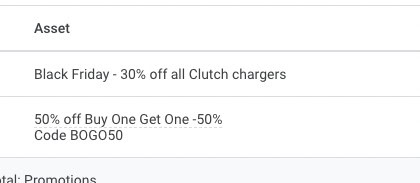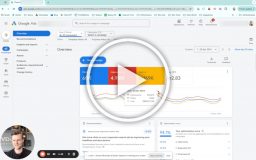SavvySession
Summary
- Run a Performance Max script to know what assets to create
- Prep your assets in advance
- Ad Copy
- Images
- Videos
- Create a campaign structure segmenting On-Sale products to allow more granular bidding
- Create a fallback campaign
- Increase your budgets carefully (important not to do it willy-nilly)
- Set seasonal bid adjustments, and manage them carefully
- After Black Friday, make sure you lower your bids proactively to avoid overspend
Intro
We already have a comprehensive Black Friday PPC guide, but I felt compelled to write a guide specific to Performance Max.
A lot of the accounts we provide roadmaps for, also known as audits, run only on Performance Max.
However, many of the things that we would typically do for our client accounts under management are simply not available in Performance Max.
So in this article, I will help you understand what:
- You should do to optimize performance during Black Friday
- You can’t do it because you can’t access that setting anymore
- Is pointless to do because it has no impact
I’ll be making some considerations on two fronts in this article:
- USA vs. Europe
- DTC vs. Resellers
There are slight differences in your approach based on whether you’re in the US or Europe and whether you’re selling your own brand or if you’re reselling other brands.
Before we get started, I want to touch on a couple of aspects:
How to gauge performance on the day?
With Google Analytics 4, we can’t see the ROAS for Google Ads on the day anymore.
There are two things you can do:
- Look at the day data in the Google Ads overview tab
- Use a third-party tool like TripleWhale, AdBeacon, WickedReports, etc.
For the Google Ads overview tab, if you select today and compare it to the same day last year (remember to change the date, so you compare the same days of the week and not the exact date), then you can see how your data is comparing up to a certain point:

In this case, it’s clear we’re spending roughly the same as we did last year.
Reviewing our number of conversions, it says we’re 6.70 down from last year:

But we haven’t counted the full day yet. We only have conversion data up to 7-8 pm. We’re, therefore, roughly in a good spot so far.
This isn’t the best way, but it will help you gain an idea of how you’re doing on the day.
Especially if you’re running server-side tracking, the numbers on the day in Google Ads can be relied upon more than in the past.
Shopping Only or Full Setup?
I’m still of the opinion that most advertisers shouldn’t use the full P-Max setup.
I haven’t seen anything in P-Max setups (yet) that convinces me that there is an advanced algorithm matching search terms with YouTube channels with Display ad inventory or doing anything behind the scenes to combine it into a full-funnel marketing campaign.
It would be very appealing, but as of Q4 2023, I do not see it in effect.
For this reason, I don’t see the point in switching to a full setup running with text ads, video ads, and display ads inside your Performance Max campaign this year for Black Friday.
If you’re already running a full setup, then there’s probably a reason for that. Although I’m not a fan of the full setup, I don’t advise changing anything but outright mistakes in your Google Ads account once you hit November 1st.
Not running the Performance Max script? It’s a must…
I recommend running a P-Max script that will show you the performance across networks. You can see the script here from Mike Rhoades.
The reason is that we’re often seeing results like this:

It is really very common across accounts we run and audit. What it’s showing is:
- The main part of spend = Google Shopping
- Secondary spend = Search
- A tiny spend on Display
- No spend on Video Ads
This is useful to know for Black Friday / Cyber Monday because it shows you what assets are worth spending resources creating for Performance Max.
If you’re not spending any money on Display or Video, then you shouldn’t spend time or money on creating assets for Black Friday (this is a good rule overall if your agency or Google is telling you to create assets — check how much spend is going to them, so you can find out if it’s worth it).
Let’s get into it…
Prep for Black Friday
Assets
If you run a full setup in Performance Max with Text Ads, Display Ads, and Video Ads, the question is: How much effort should you put into creating Black Friday / Cyber Monday creatives for each channel?
The truth is: not much.
Using the Performance Max Script or Looker Studio setups I mentioned before, you should know whether your Performance Max campaigns are getting any exposure on Display or Video.
If they don’t, then there is no need to put any effort into creating Display Ads or Video Ads.
- Add promotional ad text in the headline and description assets as you normally would
- Add promotional display banners
- Only if you’ve previously seen Display Ads getting traffic in P-Max
- Product level if you only run a few products
- Store-wide if you run +20 products
- Category-wide if you think it’s worth it
- Add promotional videos
- Only if you’ve seen videos get traction in your P-Max campaigns before.
- Typically store-wide discounts rather than focused on individual products
- Product-level if you only run a few products
- Ad extensions (only for Search Ads)
- Create promotion extensions
Should you create new asset groups for Black Friday?
- No. Creating new asset groups will confuse the system and is not intended to be created and removed consistently.
This does make it more difficult to get the right assets activated/paused at the right time, as you can’t use automated rules like we can with regular Search/Display/Video campaigns.
Note: For Shopping Ads, none of this matters.
Promotional Display Banners and Video Ad Guidelines
One of the biggest misunderstandings around Black Friday / Cyber Monday is that you should only run Black Friday-focused ads.
This might have been more relevant in the past, but today the main recommendation I have is this:
Run your evergreen ads, and simply add a Black Friday mention, such as a ribbon or a callout:


Here are some examples of what I refer to above:
Promotional Copy

Promotional Display Banners

Ad Extensions

Preparing Your Campaign Structure
There are only a few levers you can pull when you want to optimize Performance Max campaigns:
- Give better assets (if relevant)
- Change ROAS targets & budgets
- Exclude products
- Change campaign structure
I’ve gone into campaign structures for Google Shopping and Performance Max before, so I will not go through all of them in this article as it’s not relevant. If you’re not using different campaigns in Performance Max, then now is not the time to start — unless you’re running different promotions for different categories/products.
For Black Friday / Cyber Monday, you want to use Seasonal Bid Adjustments to tell Smart Bidding to bid higher for your campaigns. This is the only way to help Smart Bidding know that it should bid higher, but there is a caveat: You can only do it on a campaign level.
This means if you have all your products in one campaign but are not running a sale for all your products, then you’ll have to decide between turning off all products not on sale (not smart) and whether or not to increase your bids for all your products.
Separate Products On Sale vs Not On Sale
I always advise separating Performance Max into two campaigns for Black Friday / Cyber Monday (and for all other promotions):
- On Sale
- Regular Price (aka. not on sale)
This will allow you to do three things:
- Set a budget specifically for your products on sale
- Apply seasonal bid adjustments for products that are on sale, and will therefore improve in performance
- Apply a different seasonal bid adjustment for products not on sale (either positive or negative, depending on performance)
When segmenting your campaign into two, you should move the lowest amount of products.
This is often misunderstood by people. They will think they should move the products on sale into a different campaign to push them separately from the other products.
I’d like to repeat. That is a mistake.
You never want to move your highest-grossing products/keywords out of a working campaign. Especially a Performance Max campaign.
Instead, move the non-sale products that are less important during BFCM, and you’ll avoid any significant performance instability.
Consider Standard Shopping for Non-sale Products
Standard Shopping has a lower priority in Google’s hierarchy of campaigns compared to Performance Max.
You can use this to your advantage by moving your non-sale products into a Standard Shopping campaign instead of a second Performance Max campaign.
This allows you to tell Google:
- If a search term can match a product from our P-Max campaign (on sale) and another from our Standard Shopping campaign (not on sale), then show the product on sale.
This can help you funnel more traffic to your relevant Black Friday deals rather than splitting the traffic up.
Create at least one Standard Shopping Fallback Campaign
In addition to this, you should have a Standard Shopping campaign as a fallback campaign.
Smart Bidding in Performance Max works by increasing/decreasing your bids across a range of segments (search term, device, location, audience, etc).
Any segment that is not performing within your ROAS target will potentially bid down to a level where you’re not showing ads on this term. In normal cases, this is exactly what you want it to do.
But during Black Friday / Cyber Monday, we want to bid higher for everything. It’s long been a cheat code of ours in order to scale further on Black Friday because literally all search terms/segments will start converting better. Even segments that never convert outside of Black Friday sales.
Normally, I’d recommend using a minimum bid to make sure you increase your bids to at least a competitive level, but that option isn’t available in Performance Max. So we need to be creative.
Using the same functionality with P-Max having a higher priority than Standard Shopping to our advantage again, you can create a fallback Standard Shopping campaign to catch any search terms/segments that P-Max misses.
This would be the campaign structure:
- Performance Max: Products on Sale
- Standard Shopping: Products on Sale
- High Priority
- Set a manual bid of 50% lower than your average CPC in P-Max
- Increase the bid if your overall account ROAS is good
- If you’re very uncomfortable with manually bidding, you can also set it to a low ROAS target. Again, about half of your P-Max campaign.
- Standard Shopping: Products not on sale
- Medium Priority
- Set a target ROAS as normal
- Or, set a low manual bid about 25% lower than your normal average CPC in P-Max for the same products
This setup will ensure that any product on sale that P-Max, for some reason, isn’t bidding high enough for to get into the auctions will be covered in your Standard Shopping campaign.
Now that you have:
- Created assets across text, display, and video
- Structured your campaigns to prioritize products on sale
- Created a fallback campaign to ensure you’re maximizing exposure
We should go into what to do during Black Friday / Cyber Monday
During Black Friday: What To Do?
When I mention things to do during Black Friday, then I refer to any period during your Black Friday / Cyber Monday deals.
For some, the focus is solely on Black Friday, while others extend their deals throughout the BFCM weekend or even the entire month of November.
It doesn’t matter much, but I will comment on the difference between running Black Friday deals for the entire month of November vs just the week/weekend.
Do Not Change Your ROAS Target
I sometimes see PPC managers change their ROAS target to tell the system to bid higher.
This is generally a mistake (although outlier scenarios exist), and you should instead use seasonal bid adjustments, which we will go through below.
Starting November 1st? Don’t Use Seasonal Bid Adjustments
The reason why we use Seasonal Bid Adjustments (more on this in a second) is to tell Google to bid higher for a few days. We need to do this because Smart Bidding will not catch up with the performance increase until 1-3 days later at best.
However, when you’re running a month-long Black Friday Sale, you have more time for the algorithm to learn your new normal.
It’ll gradually get accustomed to you running a sale, and it will bid accordingly.
You therefore don’t need to use any seasonal bid adjustments until you get to the Black Friday week.
With that out of the way, here’s how to optimize your Performance Max campaigns during Black Friday.
Managing Bids/Smart Bidding During Black Friday
Even when running Smart Bidding you’re doing bid management yourself. Setting targets, changing min/max in portfolios and most importantly applying Seasonal Bid Adjustments are in fact bid management — just not manual bid management.
In this section we’ll walk you through how to use seasonal bid adjustments to nudge Smart Bidding to act faster than it normally does.
In recent years, during Black Friday, conversion rates have increased as follows:
- Monday – Wednesday: 25-50% better than normal
- Thursday: 50-100% better than normal
- Black Friday: 100-300% better than normal
- Saturday – Sunday: 50% better than normal
- *Cyber Monday: 100-200% better than normal
* For Europe, Cyber Monday is more like 25-50% better than normal.
Just to clarify, a seasonal bid adjustment is applied here:


We can use this knowledge to tailor how our seasonal bid adjustment should be set.
You can read our full guide to using Seasonal Bid Adjustments for Performance Max here, but for Black Friday, here’s the most important things to remember:
The Seasonality Bid Adjustment feature is a way to tell Smart Bidding to increase or decrease your bids temporarily.
One of our early learnings of seasonality bid adjustments was that it works “directly” Google tells you to set the adjustment to what you expect the conversion rate to increase with, but:

Be Careful with How Much to Increase Bids
A 100% Seasonality Bid Adjustment will usually result in a 100% increase in your bids, which isn’t necessarily what you want.
I remember receiving a call from a large advertiser we had a sparring retainer with on Black Friday because they had set a seasonality bid adjustment to the same as last year’s conversion rate increase, and it was blowing through the budget before 11 a.m.
When we reviewed the adjustment more closely, it was clear that the bids were way too high. Although Black Friday usually meant a 100% increase in conversion rates, the CPCs only increased 25% for this particular retailer.
A more accurate adjustment was 25% – not 100%
Using the insights from above, this is typically how we will structure Seasonal Bid Adjustments for Performance Max during the Black Friday week:
- Monday – Wednesday: 25%
- Thursday: 50%
- Black Friday: 100%
- Saturday – Sunday: 0%
- *Cyber Monday: 25-100%
*Again, Cyber Monday will change a lot based on Europe vs the US.
I recommend using your own data to help set the initial Seasonal Bid Adjustments.
Optimizing Seasonal Bid Adjustments
It’s important to note that after changing a seasonal bid adjustment approximately five times, they will stop recognizing the change. The exact amount is up for debate, but we tend to create new seasonal bid adjustments after 5-8 changes to the bid change (or if we don’t notice a change from changing the setting).
During the Days:
- Review your ad positions
- Review your ROAS on the day
- Change your bid adjustment up/down accordingly
Here’s a couple of scenarios:
- Not being shown / low click volume
- Increase your bid adjustment by 10-50%-points
- High ROAS / Not #1 spot
- Increase your bid adjustment by 10-25%-points
- Low ROAS on the day
- Decrease your bid adjustment by 10-25%-points
Stick to no more than 3-5 changes to your bid adjustments.
Managing Budgets: Not So Easy
In recent months, both myself and others have seen a shift in how Performance Max campaigns work with budget limitations.
When your campaign is limited by budget, it’ll start throttling how often your ads are shown rather than decreasing your bids.
This can cause a false sense that you have the right budget because you’ll see a high top impression share (aka. you’re shown in the top ad positions), but you’re not really getting the maximum exposure.
So managing and increasing your budgets for Black Friday is KEY.
How Much to Increase Your Budget?
If you’re running a Shopping-Only Performance Max campaign, then I recommend following the “unlimited budget” mentality:
- Increase your budget by 5x to begin with
- Then increase 50% every time you’re close to hitting your daily budget limit
The goal is never to have the “limited by budget” status on your campaign.
But budget management becomes tricky if you run a full setup with all assets.
Due to the nature of P-Max, you can’t control if Google spends more of the budget on lower ROAS display ads or profitable Shopping Ads when you increase the budget.
My best advice to you is to:
- Review how much traffic you’re getting from Display / Video using the scripts earlier
- If there is no to little traffic, then create a new asset group with only text assets and only the required image assets:

No videos.
From here, you follow the same budget approach as outlined above but just a bit more conservative:
- Increase your budget by 100% to begin with
- Then increase 50% every time you’re close to hitting your daily budget limit
If you can’t remove your assets, or you’re running with assets, then I’d recommend doing the following:
- Increase your budget by 50% to begin with
- Then increase 50% every time you’re close to hitting your daily budget limit
What we’re trying to avoid is Performance Max seeing the increasing budget as a signal to expand into new Display or Video inventory we don’t want to be in.
Note: Remember to analyze your Shopping/Search/Video/Display allocation during these days with the script. You don’t want it to change drastically unless you’re seeing a good ROAS from these.
After Black Friday
Seeing that you’ve been bidding higher during the Black Friday period, Smart Bidding will have signals to continue with the high bids that resulted in hitting the target ROAS you aimed for.
However, after Black Friday, conversion rates will drop, but Smart Bidding will still need to wait 2-7 days until it reacts to the lower conversion rates.
For this reason, I highly recommend using data exclusions and negative seasonal bid adjustments after your sale is over.
How much of a negative seasonal bid adjustment depends on how strong your Christmas season is.
Toys typically continue to see strong conversion rates, but most other categories drop back to their normal levels after Black Friday.
So here is my recommendation:
- Use a Data Exclusion to:
- Exclude the entire period Thursday to Sunday (in Europe) and Thursday to Monday (in the US)
- Cyber Monday is small in Europe compared to the other days, while Cyber Monday can be a very strong day in the US.
- Apply a negative Seasonal Bid Adjustment depending on how strong your Christmas season is:
- If strong: You can lower the bids by 25% on Tuesday/Wednesday, see how it goes, and then let it get back to normal.
- If not strong, you can lower bids by 50% Tuesday/Wednesday, then 25% Thursday/Friday/Saturday, and then let it go back to normal.
It’s important to review your performance these days:
- Too low ROAS?
- Review your CPC level.
- Is it the same as before Black Friday? Then let it stay.
- If it’s higher than before Black Friday, then decrease your Season Bid Adjustment further by -10-20% points.
- Review your CPC level.
- Too high ROAS?
- Increase your Seasonal Bid Adjustment by 10-20% points.
Final Advice: Do These Three Things
If this was more than you could handle, I don’t blame you. It was a bit of a brain dump of the best things I’ve learned over the years working with PPC on Black Friday.
If you don’t do anything else, then I recommend you do three things:
- Add Black Friday Sale to any ad
- Add the promotion extension
- Double your budget
Whatever you do, it’s crucial that you set yourself up for success on Black Friday. Take the time and acknowledge that you can’t just be in maintenance mode.
Get out of your comfort zone and start making a change in your account.
If you have any questions, let me know in the comments below!







2 thoughts on “The Truth: Performance Max Optimization for Black Friday 2023”
Andrew, in the full-asset Pmax campaign scenario, why would adding a new asset group with minimal assets contain display ads since display assets are still there?
Also, do you recommend adding a new asset group IN ADDITION TO or INSTEAD OF existing asset groups?
Thanks
Sometimes people report that they can’t create a new asset group in P-max without adding at least one image. So that’s why 🙂
Also, do you recommend adding a new asset group IN ADDITION TO or INSTEAD OF existing asset groups?
It depends, but overall for P-max I don’t see the need to create new asset groups unless it’s a scheduling thing where you want to make sure your text and image assets are approved well in advance.